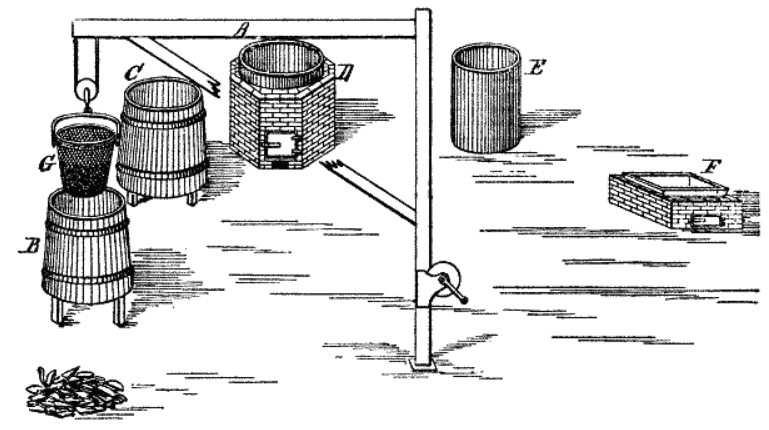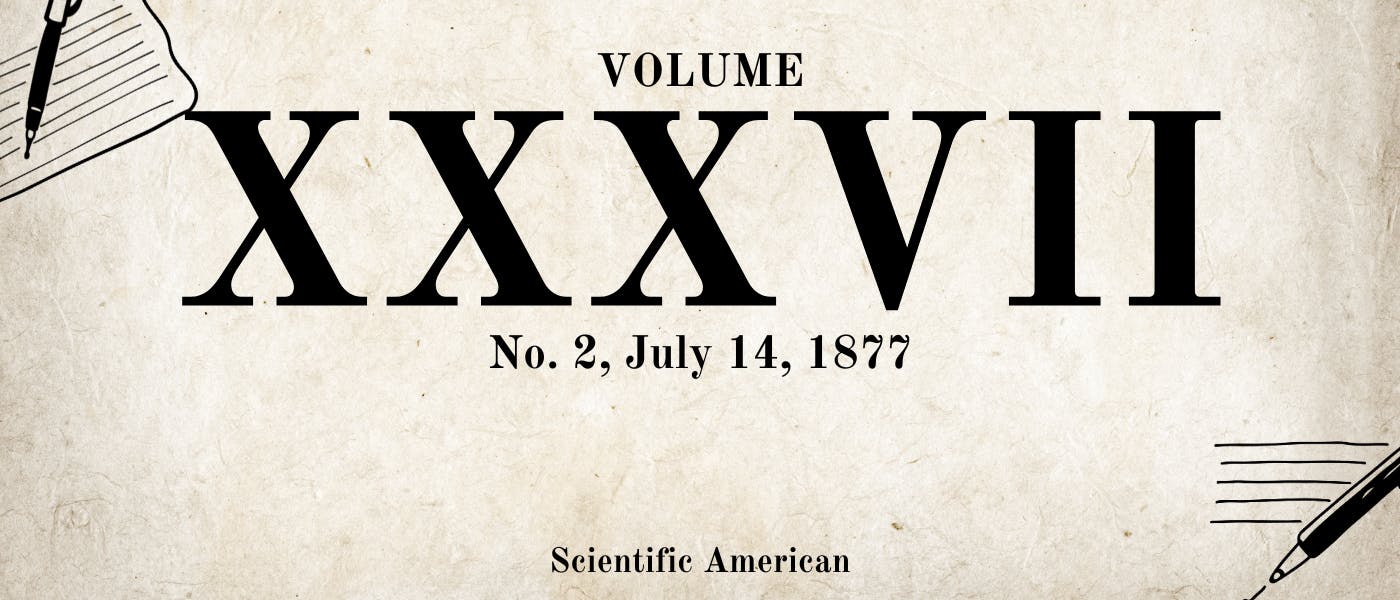Scientific American, Vol. XXXVII.—No. 2. [New Series.], July 14, 1877 by Various, is part of the HackerNoon Books Series. You can jump to any chapter in this book here. UTILIZATION OF TIN SCRAP.
UTILIZATION OF TIN SCRAP.
Messrs. Charles A. Catlin and George F. Wilson, of Providence, R. I., have patented, May 8, 1877, a new process of utilizing tin scrap, whereby they claim the tin is recovered, either as a valuable salt of that metal or in the metallic form, and the iron or other metal is left as a scrap at once available for reworking.

In any suitable building, a crane, A, is erected and placed in the sweep of that crane; in any convenient order are a boiler, D, two tanks, B and C, an evaporating pan, F, and an additional tank, E. From the crane is suspended a wire basket to contain the scrap to be treated, so perforated as to admit of the ready entrance of the liquid when submerged in, and its ready escape when withdrawn from, the boiler, D, in which boiler is put a sufficient quantity of the solution of caustic soda or potash to allow of a complete submersion therein of the basket and its contents. The basket, G, is then filled with the material to be treated, sprinkling in during the filling the requisite quantity of common salt or other chloride and nitrate of soda or other nitrate, using these dry, not in solution, either previously mixed or shaken in together in the proportion of from three to five pounds each to every hundred pounds of scrap, the requisite quantity depending upon the thickness of the tin plate to be removed. The loaded basket, being elevated by the crane, A, is then swung round, and, by lowering, submerged in the hot or boiling solution of caustic soda or potash in the iron boiler, D, which may hold in solution a further proportion of the chloride and nitrate used, the heat of which solution is maintained by a fire beneath the boiler, or in any other and ordinary way. In the ensuing reaction the oxygen of the nitrate combines with the tin to form stannic acid, and this, in turn, combining with the alkali present, forms a stannate of that base, which, entering into solution, leaves the before-plated metal tin-free, the chloride present assisting in the reaction. A further and more complex reaction takes place, by which copious fumes of ammonia are evolved, which may be utilized by proper appliances. When the reaction is complete, the basket containing the now tin-freed scrap is withdrawn from the boiler, and suspended above it long enough to drain. It is then swung over the tank, C, containing water, in which it is washed by submerging and withdrawing several times, and in like manner the washing completed in the water of the tank, B. The contents of the basket being now discharged, it is again filled with fresh scrap in the manner already described, and the process repeated. The loss by evaporation from the boiler, D, is supplied by the wash water in the tank, C; this, in turn, being supplied by the wash water in the tank, B, to which fresh water is supplied as required. When the caustic solution is sufficiently charged with the tin salt, it is allowed to deposit the impure crystals, which, being removed and drained, are redissolved in water in the iron tank, E. This solution in the iron tank, E, after filtration or decantation, is again concentrated in the evaporating pan, F, the crystals of stannate being removed from time to time, drained and dried; or the impure crystals obtained in the boiler, D, may be mixed with fine charcoal or other reducing agent, and subjected to the requisite heat for the reduction of the tin to the metallic form.
About HackerNoon Book Series: We bring you the most important technical, scientific, and insightful public domain books.
This book is part of the public domain. Various (2012). Scientific American, Vol. XXXVII. —No. 2. [New Series.], July 14, 1877. Urbana, Illinois: Project Gutenberg. Retrieved https://www.gutenberg.org/cache/epub/38481/pg38481-images.html
This eBook is for the use of anyone anywhere at no cost and with almost no restrictions whatsoever. You may copy it, give it away or re-use it under the terms of the Project Gutenberg License included with this eBook or online at www.gutenberg.org, located at https://www.gutenberg.org/policy/license.html.

